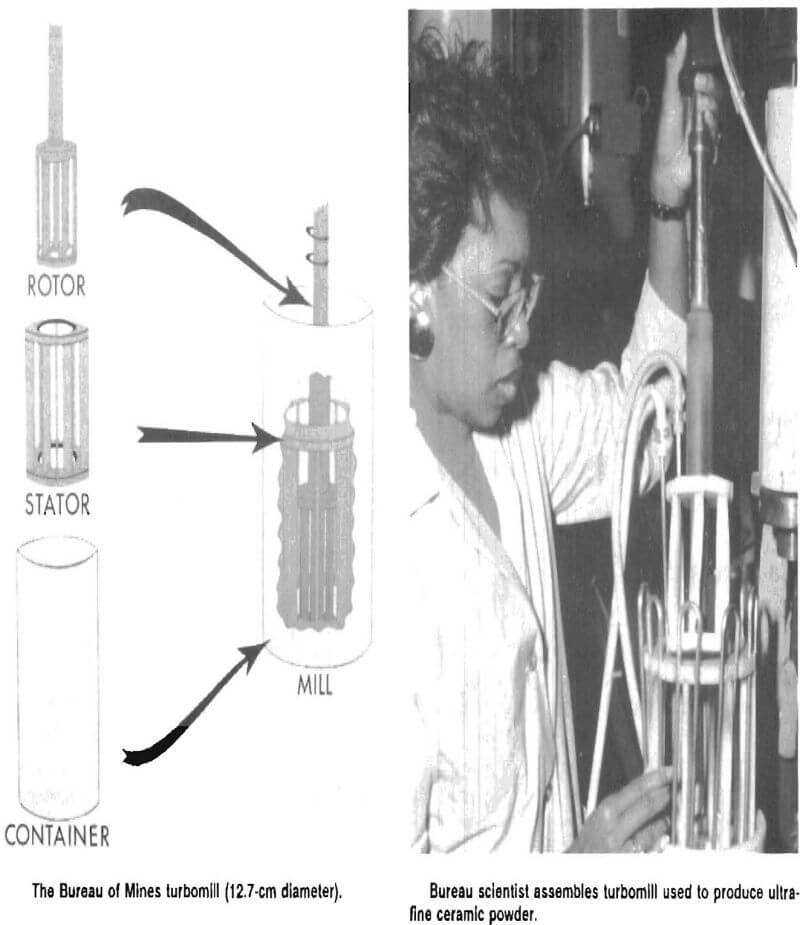Table of Contents
Objective
Utilize innovative processing technology to prepare high-purity, ultrafine advanced ceramic powders with little or no contamination occurring during the milling proccss. Advanced ceramic materials made from these powders could substitute for high-temperature alloys containing critical materials such as chromium, cobalt, and nickel.
Approach
Modify and evaluate the Bureau’s turbomill, developed earlier to grind a variety of ceramic raw materials (clay, mica, and talc), as a milling or size-reduction technique for hard and abrasive advanced ceramic powders, such as, silicon carbide.
Background
Powders for producing ceramic materials, such as silicon carbide, silicon nitride, alumina, and zirconia, which are being considered for use in severe applications requiring high-temperature and/or corrosion resistance, are very difficult to reduce to fine sizes for processing into finished parts. Traditional techniques of particle size reduction, such as ball milling and jet milling, are very energy intensive and/or slow. These traditional techniques often produce materials that have a nonuniform particle size distribution and are contaminated by the milling media or container.
The turbomill developed by the Bureau to grind ceramic raw materials to submicrometer size was constructed of metal. In advanced ceramics, however, metal inclusions have a detrimental effect on the final product; therefore, all exposed mill parts were constructed of ultrahigh-molecular-weight polyethylene, thereby eliminating contamination of the milled material by the milling vessel. Contamination by the milling media is not a problem because turbomilling is an autogenous process in which large grains or spherical balls of the same composition as the material being milled are used as the milling media.
How It Works
The turbomill consists of a cylindrical container, a cagelike stator composed of vertical bars attached to rings at the top and bottom, a cagelike rotor composed of vertical bars fixed to an upper disk attached to a drive shaft, and a frame that holds the motor and machine components. The mill is charged with a slurry consisting of the milling fluid, the material to be ground, and a milling medium The rotor rotates at speeds up to 1,600 rpm; speed, torque, and horsepower are monitored by a torque sensor mounted on the rotor shaft. The temperature of the slurry is maintained by flowing water through cooling coils to remove the heal generated during milling.
Test Results
In tests to optimize the parameters for turbomilling of alpha silicon carbide, the effects of temperature, pH, type of dispersant, and milling time on the particle size were evaluated. A 200-mesh silicon carbide powder was ground in water with 35-mesh silicon carbide grains as the milling media. It was found that Marasperse N-22, a sodium lignosulfonate, was an effective dispersant at pH 9.5 and 50° C. Eighty percent of the material was reduced to less than 1 micrometer in diameter after only 4 hours of milling. The iron content of the silicon carbide after milling was even less than that of the starting material. This reduction in iron content is due to the fact that iron is a surface contaminant of silicon carbide and as the surface is removed the iron goes into solution and is removed during washing. The energy requirement for turbomilling was 526.4 kW·h per short ton.
For More Information
U.S. Bureau of Mines Bulletin 670, “Comminution by the Attrition Grinding Process” provides information on turbomilling work prior to 1980; Report of Investigations 9097 “Effects of Turbomilling Parameters on the Comminution of α-SiC” provides further information on turbomilling of alpha silicon carbide.

